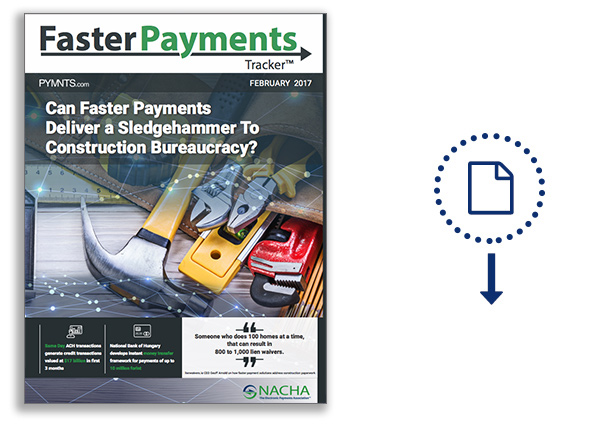Can Faster Payments Deliver A Sledgehammer To Construction Bureaucracy?

On the job, the most effective tool for a construction worker could be a hammer or saw or even a nail gun. But in terms of getting paid and dealing with red tape, faster payments solutions may increasingly be just as essential. For February’s Faster Payments Tracker™, PYMNTS spoke with Geoff Arnold, CEO of lienwaviers.io, about how faster payments solutions are helping companies and contractors eliminate the obstacles necessary to handle paperwork and exchange funds faster.
A construction worker’s tool belt can carry a host of important instruments necessary to get the job done. So, why not add a tool that can cut through red tape and paperwork more efficiently?
For all the tools available across the construction trade, faster payments solutions are not among the most utilized by employers. However, recent advancements in payment solutions are helping employees and contractors in the construction trade get paid more quickly for their work by expediting the necessary exchange of paperwork, specifically related to lien waivers.
In an effort to ensure workers (which include contractors or subcontractors) are paid for their services and materials, they can place a lien on a property until their payment is collected. When the project is completed, they sign a legal document, known as a lien waiver, acknowledging that they have been paid for their services and are relinquishing their legal right to file a lien.
While the arrangement is aimed at protecting both the rights of property owners and the ability of workers to get paid quickly, it can sometimes lead to complications, partly because the contracts often come in paper form. So, what can an old-school industry do to innovate and speed up the process of payment exchange? For the February feature story, PYMNTS spoke with Geoff Arnold, CEO and cofounder of lienwaivers.io, a company that offers a faster payment solution for the construction trade.
Construction’s “chicken-or-an-egg problem”
According to Arnold, physical paperwork is still the predominant form of data exchange in the construction industry, with most payments still executed by check. The required lien waiver documents can complicate the payment process, he said.
“Really, it’s like a chicken-or-an-egg problem,” Arnold said. “Payees do not want to release their lien rights until they’ve been paid, and payers are often required to collect these documents to protect themselves and also provide them back to whoever is financing the project.”
He gave an example of a roofer who completes a project for a client. The roofer sends an invoice to the client, and the client produces a check and drafts a lien waiver for the roofer to sign. But the roofer must physically go to an office to sign the lien waiver before they can collect their check or before the check is put in the mail.
“Often, it doesn’t happen in a timely manner,” Arnold said.
Arnold believes his company has introduced a solution for companies in the construction field by speeding up the process for both construction employees and employers. He describes the company’s solutions as a “third party” that enables the smooth exchange of paperwork and payments between contractors and employers.
“Essentially, our system kicks in, generates that lien waiver and sends it out for electronic signature notarization,” he said. “At the same time, we take the payment and hold that payment in escrow. So, we initiate an ACH transfer, we pull those funds into a trust account and there they sit.”
After the necessary signatures are submitted, the contractors can get their money at a much faster rate than by visiting an office or waiting for the mail, he said.
“Once that lien waiver is signed … we then move those funds that we’ve held in escrow into the contractor’s account,” Arnold said. “And once we receive confirmation that the money has moved, that lien waiver becomes available to the [employer].”
Arnold pointed out that getting that paperwork processed quickly can come as a relief to employers because a single project can require multiple lien waivers.
“You’ve got to understand that even a midsize homebuilder in the U.S., someone who does 100 homes at a time, can result in 800 to 1,000 lien waivers being exchanged per month,” he said. “We see this as an opportunity to go in and say, ‘There’s a better way.’”
Building a better construction payment solution
In early February, the U.S. Census Bureau reported that $1.18 billion was spent on construction in Dec. 2016. Meanwhile, the most recent data available from the Bureau of Labor Statistics indicates that the U.S. construction trade employed roughly 6.7 million workers in Dec. 2016.
With so much money on the line and so many workers in the trade, Arnold said the construction industry is ready for innovation.
“Construction is booming in the U.S., and you’re seeing more and more builders come onto the market,” he said.
As more people join the construction workforce, Arnold said, older attitudes on how business in the construction industry is conducted are starting to shift. This is because the construction workforce is attracting employees who are more tech-savvy and have a better understanding of available payment solutions.
“You’re seeing roofers who grew up with the internet nowadays,” he said. “They have this expectation that money moves fast.”
Arnold anticipates that builders, contractors and subcontractors will turn to payment solutions to help reduce their back-office costs. Smaller companies will be especially interested in finding efficient solutions, he said.
“We work with a customer who has no back office,” he said. “They do a significant amount of business per year with eight employees …. And they’re doing that by leveraging technology.”
He believes introducing faster payment options to the industry can pay off for both the employer and the employee.
“Construction is very relationship-based, so [employers] are eager to please their subcontractors as long as it doesn’t add a bunch of overhead on their part,” said Arnold.
With these solutions in place, Arnold believes lienwaivers.io has provided a valuable new instrument that was previously missing from the construction industry’s tool kit. Beyond the construction industry, Arnold believes the solutions offered can be applied to other industries that are interested in streamlining the payment process.
“We do see opportunity anywhere where documentation needs to be exchanged for payment, and there is essentially this timing issue,” he said. “Between ensuring that the documentation is returned before the payment is made and vice versa, we do see an opportunity there.”
. . . . . . . . . . . . . . . .
TO DOWNLOAD THE FEBRUARY EDITION OF THE PYMNTS.COM FASTER PAYMENTS TRACKER™, CLICK THE BUTTON BELOW.
About The Tracker
The PYMNTS Faster Payments Tracker™, powered by NACHA, is your go-to resource for staying up to date on a month-by-month basis. The Tracker highlights the contribution of different stakeholders, including institutions and technology coming together to make this happen.

